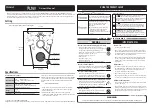
<3. INSTALLATION>
3-5
IM 01E30D01-01EN
3.3 Mounting Procedures
NOTE
• The tightening torque value to which gaskets
must be tightened varies depending on the
type and external dimensions of the lining
and the gasket. In this section, the tables
indicating tightening torque values include
the corresponding gasket types. The internal
diameters of the gaskets are close to those
of the grounding rings.
•
For fluids capable of potentially
permeating PFA linings (such as nitric acid,
hydrofluoric acid, or sodium hydrate at high
temperatures), different tightening torque
values must be applied. The tables of these
torque values is indicated in this section.
• For both lay length code 1 and lay length
code 2, the tightening torque values in
the tables can be applied if their process
connections, the lining types, and the
nominal sizes are the same.
3.3.1 Nominal Diameter 25 mm (1.0 in.) to
40 mm (1.5 in.), Wafer Type
IMPORTANT
Use bolts and nuts in compliance with the flange
ratings. When stud-type through-bolts are used,
be sure the outside diameter of the shank is
smaller than that of the thread ridge. Be sure to
choose a gasket with inner and outer diameters
that does not protrude inside the piping (Read
Subsection 3.3.4). If the inner diameter of the
gasket is too large, or outer diameter of the
gasket is too small, fluid leakage may result.
(1) Mounting Direction
Mount the flowmeter so that the flow direction of the
fluid to be measured is in line with the direction of
the arrow mark on the flowmeter.
IMPORTANT
If it is impossible to match the direction of
the arrow mark, the direction of the electrical
connection can be changed. Read Section 11.1
to do this properly.
In case the fluid being measured flows against
the arrow direction, read the parameter
J20:
Flow Direction
in this user’s manual.
(2) Mounting Centering Devices
To maintain concentricity of the flowmeter with the
pipes, install centering devices on the Mini-flanges
of the flowmeter. Use the appropriate centering
devices according to the nominal diameter and the
flange ratings.
(3) Positioning the Flowmeter
Pass two through-bolts through the adjacent holes
of both flanges and position the flowmeter so that
the Mini-flanges and the centering devices come
in close contact with each other. Pass the other
through-bolts through the other holes (Read Figure
3.3.1). In case stud-type through-bolts are used,
position them in such a way that the centering
devices come in contact with the bolt threads.
(4) Tightening Nuts
Tighten the nuts according to the torque values for
metal piping in Table 3.3.1. For PVC piping, select
an optional code of /GA, /GC, or /GD, use rubber
gaskets and tighten the nuts to the torque values for
PVC piping in Table 3.3.2.
For permeable fluids (such as nitric acid,
hydrofluoric acid, or sodium hydrate at high
temperatures), tighten the nuts according to the
torque values in Table 3.3.3.
CAUTION
For a flowmeter with fluorocarbon PFA lining,
it is possible that the nuts may loosen as time
passes, so tighten them regularly. Be sure to
tighten the nuts according to the prescribed
torque values. Tighten them diagonally with
the same torque values, step by step up to the
prescribed torque value.
















































